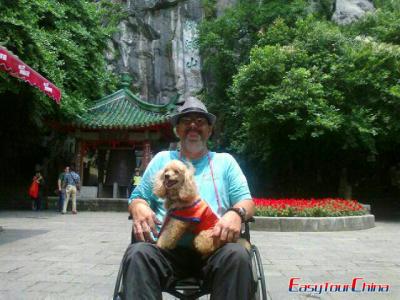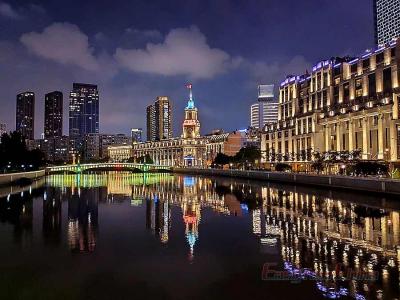Yu Garden (Yuyuan)
Yu Garden or Yuyuan Garden is located at the heart of Shanghai Old Town, a few blocks southwest of the Bund in downtown Shanghai. It is one of China's loveliest private classical gardens. Its name means Garden of Contentment, and it is indeed a pastoral world apart from modern and hectic Shanghai. The name of Yu Garden is a general term which includes the classical Chinese garden inside and surrounding old town, pavilions, bazaar and other attractions. It’s regarded as “the garden of Shanghai city”, and named one of the top 5 classical gardens in Shanghai.
In the garden, there is a famed stone Yulinglong, which is called the three renowned stones in the south of China; Dianchuntang, a command post in 1853, plaques and carvings from masters are all of the representative scenic spots of Yu Garden. Another attractive place around is a local bazaar, Yuyuan Market, besides commodities, it is also a paradise for food lovers. You can enjoy a relaxing and interestingYu Garden trip as you’re tasting Shanghai food and snacks like Xiaolongbao, Da Zha Xie, etc.
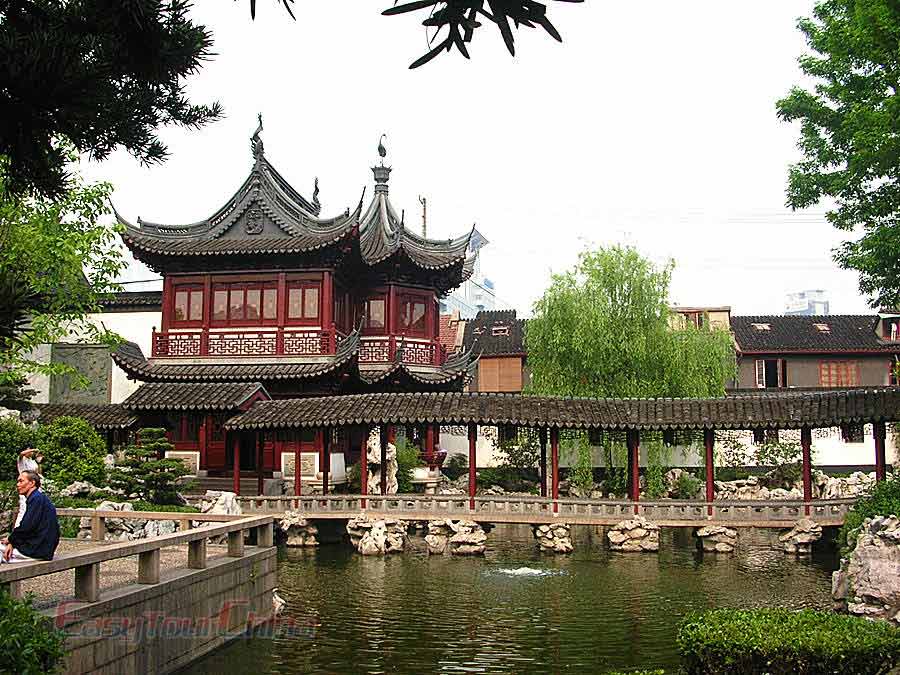
Shanghai Yu Garden Facts
Yu Garden History & Development
Yuyuan Garden has a history of over 400 years. Its construction was first built in 1559 and completed in 1577. Its owner was Pan Yunduan, an official, as the private estate for his father, who served in the Ming Dynasty as the governor of Sichuan. Laid out by a landscape artist, Zhan Nanyang, it has become one of the most renowned gardens in South China. In the late of Ming dynasty, the family of Pan Yundun declined. As the Pan family declined, the garden was gradually abandoned and the garden was transferred to Zhang Zhaolin.
The portion known as the Inner Garden (Nei Yuan) was added in 1709. It is a remarkable maze of gorgeous Ming Dynasty pavilions and elaborate rockeries, arched bridges, and goldfish ponds, encircled by a massive, undulating dragon wall. Occupying just 5 hectares (12.5 acres), Yu Garden nevertheless seems as expansive as a small town, with room for 30 pavilions.
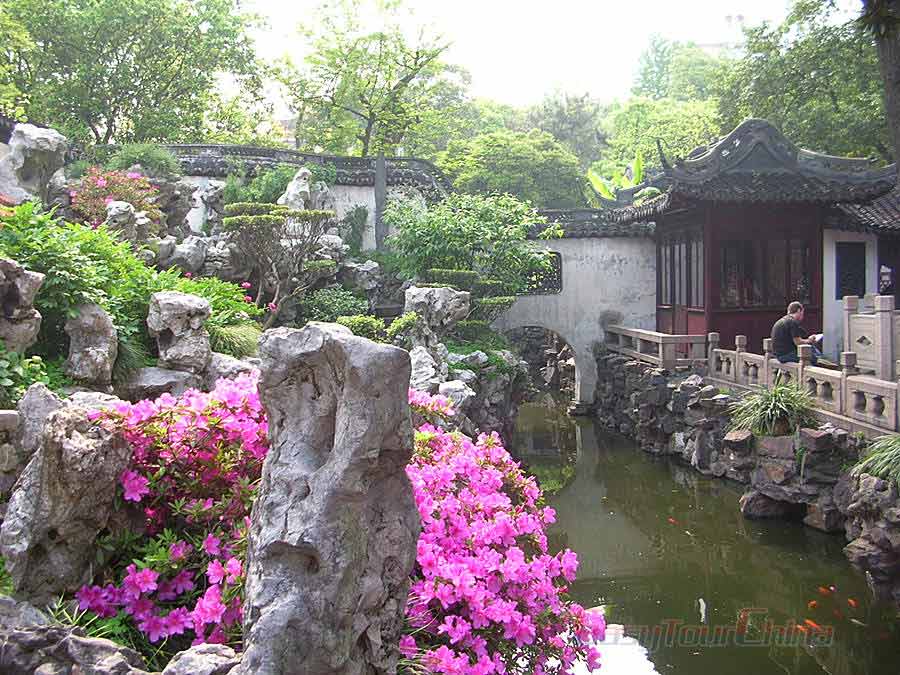
Until 1760, the local gentry restored it again. It became the headquarters of the Small-Sword (Dagger) Society Uprising against foreign imperialists in Shanghai, Xiamen and other parts of China in 1853. During the early time of Taiping Heavenly Kingdom Revolution (1851-1864), it was damaged badly. Part of the garden became the bazaar and local guildhalls, but over 20,000 square meters remain of tall rockeries, halls, ponds and pavilions linked by zigzag corridors. In spite of this, Yu Garden has been ravaged by wars and many of its monuments have been destroyed.
In 1956, Yu Garden underwent a large-scale renovation, which took five years and reopened to the public in September 1961. And it was listed into national cultural relics in 1982.
>> Recommended Shanghai tour to Yu Garden: 3-day Shanghai Highlights Tour
Layout
The Yuyuan Garden is about 100 meters long from east to west and 230 meters long from north to south. Most of each courtyard in the garden has relatively independent areas and boundaries.
Entering the main gate of Yuyuan Garden from the Jiuqu Bridge by the Lotus Pond is the San Sui Hall. Immediately behind the Hall is a two-story hall looking across the Lotus Pond to the large rockery. The hall on the ground floor is called Yangshan Hall, and the building is called Rolling Rain Tower. To the east of Yangshan Hall, there is a half-spanning porch on the water. In front of the corridor are two iron lions of the Yuan Dynasty. To the east of the big rockery, across the stone bridge, there is a lake stone rockery. The Cuixiu Hall is located at the eastern foot of the rockery. Looking southeast, one can see the "Yule Pavilion" spanning the stream. To the east, there is a corridor, and to the west of the corridor, there is a square pavilion.
Passing through the corridor, on the left is the Wanhua Tower, which was rebuilt in the 23rd year of the Daoguang reign of the Qing Dynasty (1843). It is the site of the Flower Goddess Pavilion of the Ming Dynasty, and the existing buildings were rebuilt in the Qing Dynasty. To the east of the Wanhua Tower, there is a dragon wall. Passing through the dragon wall, the main building is the Dianchun Hall. Opposite the hall of Dianchun Hall is a small stage surrounded by water on three sides. Behind the stage, there is a pool. To the south of the pool is the "Hexu Hall". To the west of the stage, there is a Double Dragon Playing with a Pearl doorway. To the west of the doorway is a long and narrow pool from north to south. To the east of the pool is the Huijing Tower, which was built in the ninth year of the Tongzhi reign of the Qing Dynasty (1870). It is a two-story pavilion.
At the southern end of the large pond, opposite the viewing tower is the Liushang Pavilion, which faces water on both sides. Crossing the three-curved plank bridge, one is greeted by exquisite and precious stones. Opposite Yu Linglong is Yu Hua Hall. To the west of Yulinglong, there is a round cave gate. Entering the cave gate, you will find a rectangular courtyard. In the courtyard, there is a two-story "Deyue Tower", and outside there is a corridor called "Baishou Corridor". The Deyue Tower is located to the west of the Lotus Pond.
The layout of China's Yu Garden creates a pattern of harmonious coexistence and poetic Chinese dwelling between humans and nature.
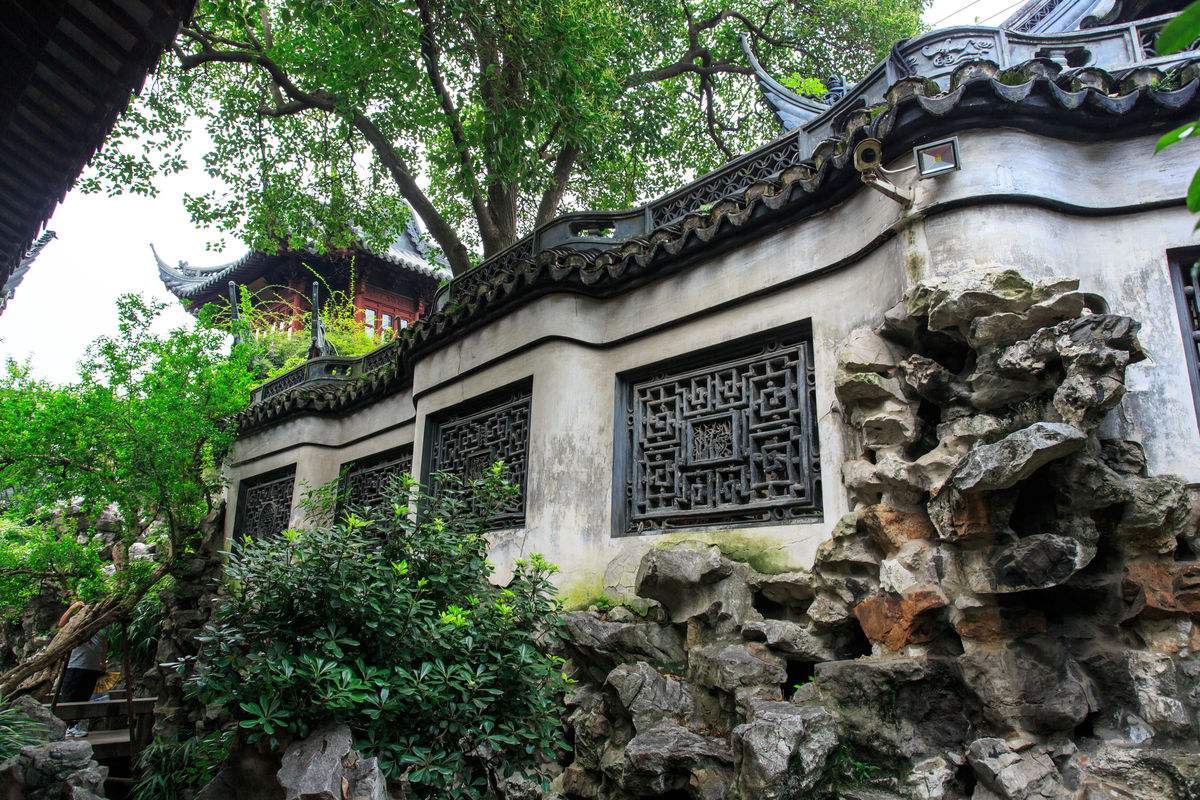
Main Architectures and Highlights
Huxin Pavilion (湖心亭)
The Huxin Pavilion Teahouse in the Yu Garden is hailed as "the No. 1 Teahouse in Shanghai". the oldest and most renowned teahouse in Shanghai, It is also one of the existing ancient architectural landscapes in the city as well as the location of the earliest chamber of commerce in Shanghai. The teahouse stands in the middle of the water and is accessible by a nine-bend bridge. The teahouse has become one of the symbols of Shanghai's history for being located in the protected Ming and Qing Dynasty structure.
San Sui Hall (三穗堂)
Located in the northeastern part of the Yu Garden, it was built in the 25th year of the Qianlong reign of the Qing Dynasty (1760), with the meaning of "the wise are happy and the benevolent live long". In the early Qing Dynasty, the San Sui Hall was expropriated as the office of the Shanghai County Government. In the late Qing Dynasty, this place became the benchmark for the soybean and rice industry and the place of cultivation.
Wanhua Tower (万花楼)
The Wanhua Tower is located in the northern part of the Yu Garden and was rebuilt in the 23rd year of the Daoguang reign of the Qing Dynasty (1843). It was named "Shen Chi Tang" because humans and deities are just a stone's throw apart. After the founding of the People's Republic of China, it was renamed "Wan Hua Lou". The most numerous sculptures here are related to the Eight Immortals, embodying the owner's aspiration to achieve enlightenment and become an immortal.
Shanghai Yu Garden Bazaar
Close to the famous Yu Garden and the Shanghai City God Temple and Yuyuan Bazaar is the perfect place to explore Shanghai's historical streets blended with modern commerce. It is also a shopper's paradise and a culinary kingdom.
>> Recommended 5-day Shanghai Family Tour
What to Do?
1. Appreciate the art of classical Chinese gardens. Chinese classical gardens are regarded as one of the four representative gardens in the world. Among them, the large imperial gardens in the north and small private gardens in the south are two different styles. This time, you don’t need to make a special trip to the “Garden City”, Suzhou, you can see an outstanding classical garden in Shanghai, which fully shows the characteristics of Chinese classical aesthetics.
>> Recommended 5-day Shanghai/Suzhou/Tongli Tour Package
2. Study the architectural characteristics of Ming and Qing dynasties. Chinese traditional architecture not only embodies the aesthetic value, but also contains rich craft culture. You can explore the glamour of architecture in the garden.
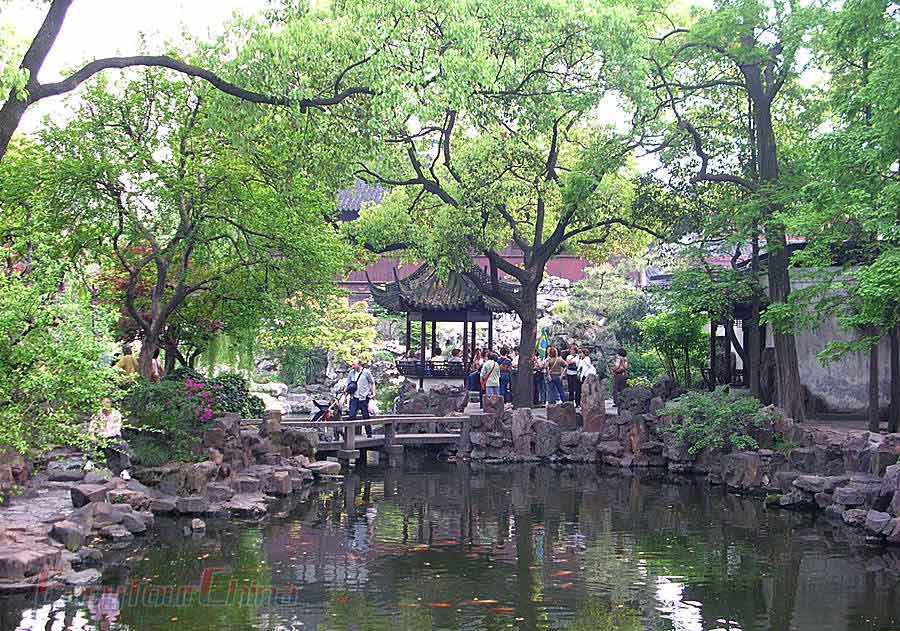
3. Take a walk in the garden to enjoy the cool and experience the leisure time. Do as an ancient Chinese people did, take your time and enjoy the fun in the beautiful garden. Whatever you want to play among the flowers or see the historical relics.
4. Taste delicious snacks at Yuyuan Market. Try some street food or snacks like locals, searching for favorite foods in this modern metropolis.
5. Choose souvenirs for your friends at Yuyuan Market. There are different kinds of goods and souvenirs sold in the Yuyuan Market. If you want to buy something for your families or friends, there will be your best choice in Shanghai.
How to Get to Yu Garden Shanghai?
By metro: Yu Garden is in the city center so it’s convenient to take subway. Getting on Shanghai subway Line 10 and getting off at Yuyuan (Yu Garden) Station, your destination will come into your eyes.
By bus: Public transport like Bus11, 26, 64, 71, 145, 581, 715, 730, 736, 801, 926, 929, 932, 969, 980 can also stop at Yuyuan Station.
>> Recommended 3-day Pre/Post Cruise Shanghai Shore Excursion Tour
Practical Travel tips for Visiting Yu Garden
Must-knowns
- The paths in the classical garden are uneven, with many areas such as steps, stone Bridges, ramps, ponds, rockeries, caves, low tree branches and moss. Please pay attention to the safety warning signs throughout the garden and always be vigilant about your safety during your visit.
- It is recommended that visitors who are elderly, weak, sick, disabled, or pregnant be accompanied by a guardian when entering the park.
- The ecological environment in the garden is good. Occasionally, wild small animals may appear. Chasing, touching, feeding and taking photos are prohibited.
- In case of renovation of ancient buildings, maintenance of gardens or temporary closure of some scenic spots in the park, please follow the safety passages indicated by the park authorities.
- Yu Garden is suitable for walking Tours. If you do need to use a stroller or wheelchair, please always pay attention to safety. >> Check out China Disabled Tours
- Visitors are prohibited from bringing pets into the park (except guide dogs).
- Senior citizen ticket: Seniors aged 60 and above can enjoy a 50% discount with their ID card or other valid identification. >> Explore A Complete Travel Guide to China for Senior Citizens (with Discount Strategy)
Restaurants
Shanghai Yuyuan Garden has Michelin restaurants (such as Nanxiang Steamed Buns Restaurant, Lu Bo Lang - Shanghai, Dà Hú Chūn) as well as a variety of food stalls. The list of must-try dishes in Shanghai Yu Garden includes vegetarian buns at Spring Breeze Song Yue Lou, fragrant lemon cake at Lu Bo Lang, fish roe, corn and meat Xiao Long at Nan Xiang Steamed Buns, five-spice beans at Old Chenghuang Temple, and more!
>> Related reading: Shanghai’s Michelin-starred Restaurants
Hotels
There are many hotels of different levels and styles next to Yu Garden. Recommended luxury hotels are Renaissance Shanghai Yu Garden Hotel, Les Suites Orient, Bund Shanghai, Waldorf Astoria Shanghai on the Bund. Recommended budget hotels include Shanghai Yu Garden Hotel, IBIS Shanghai Yu Garden.

Ready to Book a Shanghai Yu Garden Tour?
If you want to visit more Shanghai attractions in a day, a recommended method is that join a bus tour or customize a private Shanghai city tour. There are some sightseeing buses to transfer you to different scenic spots (without guide, just like public buses which skip unnecessary stations), and you can take it several time in a day. Sightseeing bus Red Line has a stop at Old Town & Yu Garden, you can get off here and walk to your destination.
How about a tailor-made Shanghai private tour with Easy Tour China? Picture this: a guided walk tour on the Bund and Yu Garden, ascending the Shanghai Tower, a family trip to Shanghai Museum, a historical tour to Shanghai French Concession and Zhujiajiao Water Town, and relaxing on the panoramic deck of Huangpu River.
More Attractions in Shanghai
